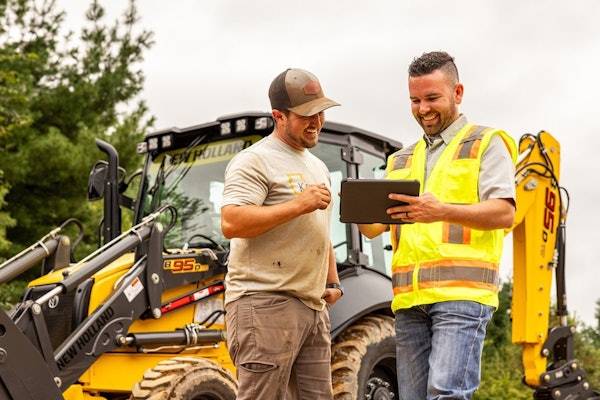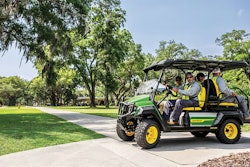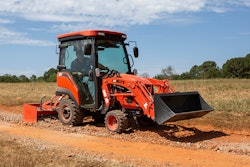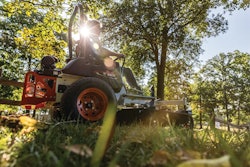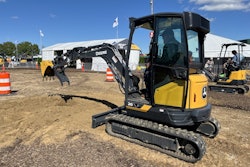Imagine your clients entertaining guests in their backyards on a sweltering, 95-degree afternoon.
Not a pretty picture? It can be.
With a high-pressure misting system at work, people could gather on a patio, gazebo or at a poolside bar and bask in comfortable 70-degree temperatures – without a drop of moisture touching their skin. They could tour the garden along lushly landscaped walkways or lounge in a swing without sweating or being harassed by insects. They might watch, entranced, as clouds of smoky mist billow from waterfalls and rise up through shrubs and trees, creating the ambiance of a tropical morning or foggy lagoon. And these pleasant memories are courtesy of the misting system you installed for the homeowner.
Misting systems serve two purposes, says Jay Archer, president of John Jay Land Development in Katonah, New York. They provide physical comfort and create visual interest. “Through the hottest part of the year, they’re helpful in allowing people to enjoy an otherwise almost unusable outdoor space,” says Archer, who has been integrating misting systems into all his concept designs for the past two years.
The systems aren’t a hard sell, even though most homeowners in his area aren’t familiar with them, says Steve Culbert, owner of Everything Green Designs in Northport, New York. With every job he does, Culbert informs clients misting systems are available and performs a demonstration outside his office. “It kind of sells itself,” he says.
Still, misting systems aren’t for everyone. Customers who elect to add them to their landscapes tend to own homes worth $1 million or more and do a lot of outdoor entertaining.
Not-so-new technology
While high-pressure misting systems – as opposed to low-pressure systems that spray people with water – have been around about 20 years, they’re just beginning to penetrate the residential market. “The story has taken awhile to get out,” says Ira Ravitz, chief operating officer of NYMist, a misting system distributor covering the Northeast. He says a lack of advertising caused the delay, but the market is wide open now.
“It’s trickled down from the high-end commercial market to the market landscapers’ clients can afford,” says Jerry Rike, owner of Rapid Cool USA, a misting system manufacturer headquartered in Los Angeles.
“People are seeing misting systems in these places, they’re wanting them and it’s catching on,” Ravitz says.
How it works
Flash evaporation is the key to high-pressure misting systems. A pump forces water out of nozzles at 1,000 pounds per square inch of pressure, producing billions of water droplets 8 to 10 microns in diameter. Essentially a fog, these droplets evaporate within a few feet of the nozzles. Low-pressure systems, on the other hand, create droplets that are about 25 microns in diameter and don’t evaporate quickly.
Energy – in the form of heat – is required for water to evaporate. So as the mist disperses, it takes heat out of the air, decreasing temperature by as much as 30 degrees. Rike compares it to walking past a sprinkler on a hot afternoon. Even if you don’t get close enough to feel any moisture, the air is noticeably cooler.
A system consists of the pump, tubing and nozzles. It requires a water source and 110-volt electricity. Ravitz says the tubing can be made of black nylon, copper or stainless steel. Flexible tubing buried 6 to 8 inches deep connects to the pump, while a metal mist line runs along the open sides of an overhang. Patios, arbors, swings, outdoor bars, balconies and terraces are good locations as long as they have an overhead structure to house the misting line. Nozzles need to be placed at least 71/2 feet high so that water will evaporate before reaching people standing below them. Typical nozzle spacing is 24 inches, but in exceptionally hot, dry climates 18-inch spacing is common.
The average pump is 24 inches by 11 inches by 12 inches, Rike says, and it can be located up to 200 feet from the misting zone. The pump can be mounted on the ground, on a wall, in a pool house or basement. A rectangular enclosure with louvers for ventilation is also available. Rike says pumps make a small amount of noise – about 40 decibels. Homeowners can control the pump via remote control or a keypad.
Profit margins
For property owners, misting systems cost between $3,000 and $25,000. Ravitz says profit margins for landscapers who install them can be as high as 800 percent. That’s because the pump is the most expensive component of the system. Additional nozzles and tubing needed to turn an average system into a large one are relatively cheap. “As you increase the number of nozzles, the profit margin increases exponentially,” Ravitz says.
A minimum installation would include a small pump and 15 nozzles, while large systems can have multiple zones and hundreds of nozzles. Rike, for instance, is working on a job that will include 300 feet of mist line and misting zones at a tennis court, colonnade, several balconies and a patio.
Cubert says the systems he installs average about $5,000, and he sees a decent profit margin of 30 percent. Archer says the profit margin is as good as that for any other unnecessary, but valuable item. He puts misting systems in the same profit category as pools, outdoor fireplaces and kitchens, lighting and unique water features.
Maintenance can provide a revenue stream as well. Water should be removed from the system and pumps should be serviced in winter, Ravitz says. NY Mist employees bring pumps to the company’s warehouse for routine maintenance such as oil changes and belt replacement and then store them. When the weather warms, they return the pumps to customers’ properties and test the systems.
The potential for growth in the residential misting system market is vast, Ravitz says. In his area there are 200,000 homes worth more than $2 million, and only a tiny fraction already have misting systems.
HERE’S A TIP
Freestanding air conditioning units
For uncovered spaces such as tennis courts and putting greens, attractive, freestanding units that can cool a 250-square-foot area are available. These outdoor air conditioners pull in hot air, flash it with high-pressure water and then blow out cool, dry air. Non-evaporated water pumps to a drain.


